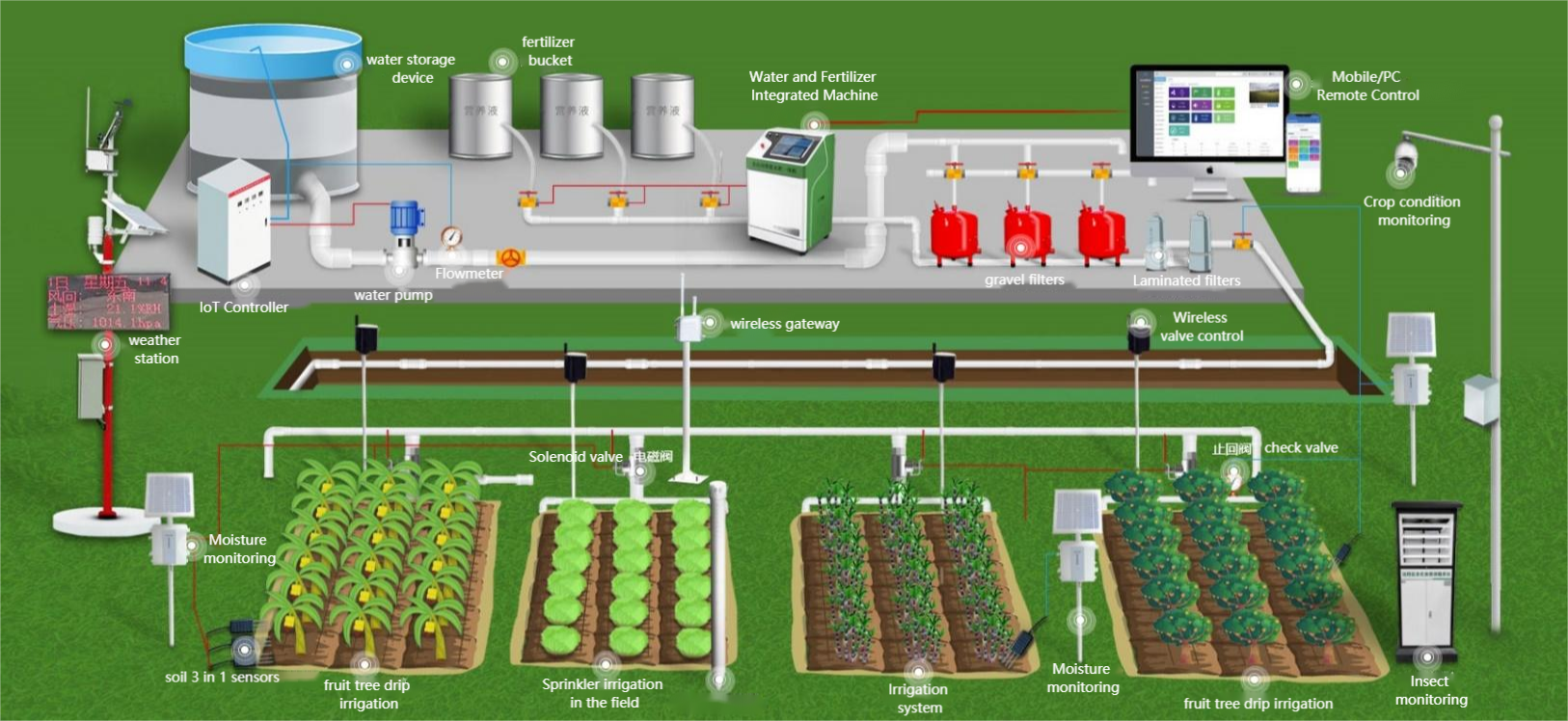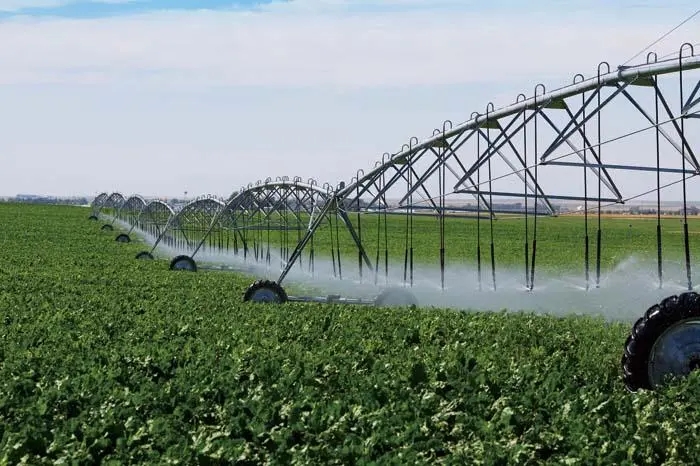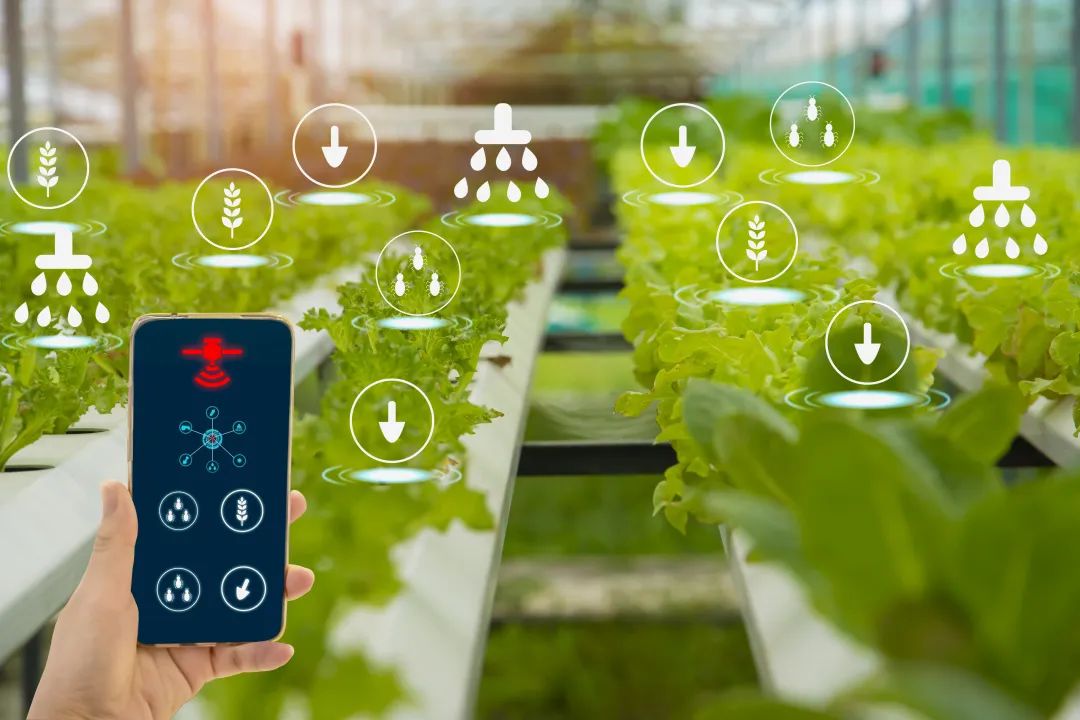

— Blogs —
—Products—
 Consumer hotline +8618073152920
Consumer hotline +8618073152920 WhatsApp:+8615367865107
Address:Room 102, District D, Houhu Industrial Park, Yuelu District, Changsha City, Hunan Province, China
Product knowledge
Time:2024-09-01 16:13:41 Popularity:1594
Automated irrigation with a smart greenhouse monitoring system relies on a series of sensors, smart control units, and irrigation equipment working in tandem. Below are the specific steps and components:

- Step 1: The soil moisture sensor monitors the soil moisture condition in real time and sends the data to the data collector.
- Step 2: The data collector transmits the data to the central control unit.
- Step 3: The central control unit analyses the data and sends an instruction to turn on irrigation if the soil moisture is below a preset lower threshold.
- Step 4: The irrigation controller receives the instruction, opens the solenoid valve and pump, and starts irrigation.
- Step 5: When the soil moisture reaches the preset upper limit threshold, the central control unit sends an instruction to stop irrigation.
- Step 6: The irrigation controller closes the solenoid valve and pump and stops irrigation.
1. Sensor deployment
- Soil Moisture Sensor: installed in the soil inside the greenhouse, installed in the soil near the roots of the crop, continuously monitoring the moisture content of the soil. The sensor sends a signal to the intelligent control unit when the soil moisture is below a preset threshold.
- Environmental sensors: including temperature, humidity, light and other sensors, are used to monitor the overall environmental conditions in the greenhouse to help the system determine whether irrigation is needed and the amount of irrigation.
2. Data collection and processing
- Data collector: collects sensor data and transmits it to the central control unit.
- Intelligent Central Control Unit: receives data from the sensors and analyses soil moisture, crop requirements and environmental conditions through built-in algorithms. Based on this information, the intelligent control unit decides whether to start the irrigation system or not, and the duration and amount of water to be irrigated.
3. Irrigation Decision Logic
- Pre-set conditions: set the upper and lower thresholds of soil moisture according to the crop's water demand pattern and soil type.
- Real-time monitoring: CCU monitors soil moisture in real time and compares it with the preset threshold.
- Irrigation strategy adjustment: The intelligent control unit can dynamically adjust the irrigation strategy based on historical data and crop growth stage to ensure that the irrigation amount meets the crop demand while avoiding waste.

4. Irrigation Execution
- Irrigation controller: control the start and stop of the irrigation system according to the instruction from CCU.
- Actuator:
- Pump: used to transport water from the water source to the irrigation system, ensuring that the water reaches all irrigation points in the greenhouse.
- Solenoid Valve: connected to the irrigation pipework and switched on and off by the Intelligent Control Unit. When the system decides that irrigation is required, the solenoid valve opens, allowing water to flow into the greenhouse.
- Drip or sprinkler system: Depending on the specific needs of the greenhouse and the type of crop, drip or sprinkler irrigation is selected. Drip irrigation systems deliver water directly to the roots of the crop, reducing water evaporation; sprinkler systems are used for crops that require more extensive coverage.
5. Monitoring and Feedback
- Remote monitoring platform: Users can view the irrigation status in the greenhouse in real time via mobile phone APP or web terminal, including soil moisture, irrigation time, water consumption and other information.
- Abnormal Alarm: The system will automatically send an alarm notification when it detects an irrigation system failure (e.g. solenoid valve malfunction, pipe clogging) or abnormal soil humidity, so that it can be dealt with in time.
6. Energy consumption management and optimisation
- Energy management technology: The intelligent greenhouse monitoring system can combine light intensity and environmental parameters inside and outside the greenhouse to dynamically adjust the irrigation time, avoiding irrigation in low light or at night, thus saving energy.
- Data analysis: Long-term collected irrigation data can be used to optimise irrigation strategies, reduce water waste and improve irrigation efficiency.
7. System Optimisation
- Time scheduling: Set up irrigation schedules according to crop water demand patterns and weather conditions.
- Water Adjustment: Adjust the amount of irrigation water according to soil type and crop water demand.
- Feedback adjustment: The system adjusts the irrigation strategy according to the feedback of soil moisture after irrigation.
Through the above steps, the intelligent greenhouse monitoring system is able to achieve accurate and automated irrigation, which not only improves the irrigation efficiency and reduces the waste of water, but also reduces the manpower cost and provides the best growing environment for the crops.

- Save water: Reduce water waste through precision irrigation.
- Improve efficiency: Automated irrigation systems reduce manual labour and improve management efficiency.
- Optimise the growing environment: Ensure crops receive the right amount of water to promote healthy growth.
With such an intelligent greenhouse monitoring system, efficient, water-saving automatic irrigation can be achieved, greatly enhancing the productivity and intelligence of modern agriculture.
Maintaining the smart greenhouse monitoring system is the key to ensuring its long-term stable operation and accurate monitoring. Here are some basic steps and suggestions for maintaining the system:
1. Check the sensors regularly
- Clean sensors: Clean dust, dirt or plant residue from sensors regularly to maintain their sensitivity and accuracy.
- Calibrate Sensors: Calibrate sensors regularly according to the manufacturer's guidelines to ensure accurate readings.
- Check sensor condition: Check sensors for damage or wear and replace damaged sensors promptly.
2. Data Collector and Central Control Unit (CCU)
- Software update: Regularly check and update the software of the data collector and CCU to fix bugs and improve performance.
- Hardware Check: Check the hardware parts of the data collector and CCU regularly, including circuit boards, connectors and power supply.
- Backup data: Backup system data regularly to prevent data loss.

3. Irrigation system
- Inspection of pipelines: Regularly check the irrigation pipelines for leakage, blockage or damage and repair them in time.
- Solenoid valves and pumps: Check the working condition of solenoid valves and pumps to ensure that they switch on and off properly according to instructions.
- Filtration system: Clean or replace the filters of the irrigation system regularly, if any.
4. Power supply system
- Power supply check: Make sure all equipment has a stable power supply, check that power cords and sockets are in good condition.
- Backup Power: Maintain a backup power system (e.g., UPS) to ensure that the system remains operational in the event of a power outage.
5. Network and Communications
- Signal Check: Ensure that wireless signals or wired connections are stable and free of interference or attenuation.
- Network Security: Protect the system from network attacks, update firewalls and passwords regularly.
6. Overall system check
- Functionality Test: Conduct regular system functionality tests to ensure that all components (sensors, controllers, actuators) work together.
- User Training: Train operators to ensure they understand the system's operation and maintenance procedures.
7. Records and maintenance logs
- Maintenance Log: Record all maintenance activities, including date, time, what was maintained, and any problems found.
- Failure logs: Record system failures and repair processes for future troubleshooting and prevention.
8. Professional Maintenance
- Regular professional inspections: Invite professional technicians to carry out inspections and maintenance on a regular basis, especially for complex system components.

Through these maintenance measures, it can ensure the long-term efficient and accurate operation of the intelligent greenhouse monitoring system, reduce the occurrence of failures and extend the service life of the system.
Related recommendations
Sensors & Weather Stations Catalog
Agriculture Sensors and Weather Stations Catalog-NiuBoL.pdf
Weather Stations Catalog-NiuBoL.pdf
Related products
 Combined air temperature and relative humidity sensor
Combined air temperature and relative humidity sensor Soil Moisture Temperature sensor for irrigation
Soil Moisture Temperature sensor for irrigation Soil pH sensor RS485 soil Testing instrument soil ph meter for agriculture
Soil pH sensor RS485 soil Testing instrument soil ph meter for agriculture Wind Speed sensor Output Modbus/RS485/Analog/0-5V/4-20mA
Wind Speed sensor Output Modbus/RS485/Analog/0-5V/4-20mA Tipping bucket rain gauge for weather monitoring auto rainfall sensor RS485/Outdoor/stainless steel
Tipping bucket rain gauge for weather monitoring auto rainfall sensor RS485/Outdoor/stainless steel Pyranometer Solar Radiation Sensor 4-20mA/RS485
Pyranometer Solar Radiation Sensor 4-20mA/RS485
Screenshot, WhatsApp to identify the QR code
WhatsApp number:+8615367865107
(Click on WhatsApp to copy and add friends)
